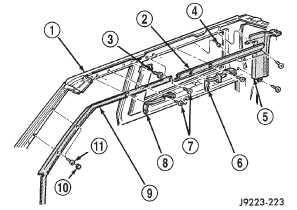Jeep Cherokee (XJ): Rearview mirror support bracket. Sunvisors. Headliner
INSTALLATION (1) Mark the position for the mirror bracket on the
outside of the windshield glass with a wax pencil.
(2) Clean the bracket contact area on the glass.
Use a mild powdered cleanser on a cloth saturated
with isopropyl (rubbing) alcohol. Finally, clean the
glass with a paper towel dampened with alcohol.
(3) Sand the surface on the support bracket with
fine grit-sandpaper. Wipe the bracket surface clean
with a paper towel.
(4) Apply accelerator to the surface on the bracket
according to the following instructions: (5) Apply adhesive accelerator to the bracket contact
surface on the windshield glass. Allow the accelerator
to dry for one minute. Do not touch the glass
contact surface after the accelerator has been
applied.
(6) Install the bracket according to the following
instructions: NOTE: Verify that the mirror support bracket is correctly
aligned, because the adhesive will cure rapidly.
(7) Allow the adhesive to cure for 8-10 minutes.
Remove any excess adhesive with an alcohol-dampened
cloth.
(8) Allow the adhesive to cure for an additional
8-10 minutes before installing the mirror. REMOVAL (1) Remove the screws that attach the sunvisor
arm support bracket to the headliner and the roof
panel (Fig. 81) and (Fig. 82).
(2) Disconnect vanity lamp connector, if equipped.
(3) Detach the sunvisor from the support clip.
(4) Remove the sunvisor from the vehicle.
(5) Remove the retaining screw and support clip.
On vehicles equipped with an overhead console, the
support clip is integral with the overhead console.
1 - HEADLINER INSTALLATION (1) Install the support bracket and the retaining
screw.
(2) Connect vanity lamp connector, if equipped.
(3) Position the sunvisor in the support clip and
align the arm support bracket holes with the headliner
holes.
(4) Install the screws that attach the sunvisor arm
support bracket to the headliner and the roof panel. The upper trim moldings and the headliner are
attached to the roof rail with a combination of
screws, clip retainers and rail retainers (Fig. 83).
To remove a headliner, all of the upper trim moldings
must be removed from the perimeter of the
headliner along with (as applicable):
1 - HEADLINER
1 - ROOF RAIL Refer to the appropriate removal and installation
procedure locate in this section or in Group 8, Electrical. REMOVAL CAUTION: The headliner is a one-piece, molded
component (Fig. 84). It has limited flexibility and
must not be bent during removal/installation.
(1) Remove the upper trim moldings from the
perimeter of the headliner (Fig. 85).
(2) Ensure that all the retainer clips and screws
are disengaged before removing the headliner.
(3) Disengage tabs attaching headliner/speaker
structure to roof rail, if equipped (Fig. 84).
(4) Disengage rear speaker harness connector, if
equipped.
1 - TAB INSTALLATION (1) Engage tabs attaching headliner/speaker structure
to roof rail, if equipped. (Fig. 84)
(2) On vehicles without headliner speakers, ensure
that the retainer clips on upper liftgate opening trim
and rails are installed. (Fig. 86)
(3) Engage rear speaker harness connector.
(4) Install the upper trim moldings around the
perimeter of the headliner. Tighten the retaining
screws to 1 N·m (11 in. lbs.) torque.
(5) As applicable, install:
1 - ROOF RAIL
1 - CLIPRearview mirror support bracket
Sunvisors

Fig. 81 Sunvisor
2 - VEHICLE ROOF
3 - HEADLINER
4 - SUPPORT CLIP
5 - SCREW
6 - SUN VISOR
7 - SCREW
8 - SUN VISOR ARM SUPPORT BRACKETHeadliner

Fig. 82 Sunvisor w/Vanity Lamp
2 - SUPPORT CLIP
3 - SUNVISOR
Fig. 83 Headliner Trim Moldings
2 - HEADLINER MOULDING
3 - SCREW
4 - SPACER
5 - LIFTGATE PILLAR TRIM COVER
6 - ASSIST HANDLE
7 - SCREW
8 - ASSIST HANDLE
9 - WINDSHIELD SIDE MOULDING
10 - COVER PLUG
11 - SCREW

Fig. 84 Headliner
2 - SPEAKER
3 - GRILLE
4 - CARGO LAMP
5 - HEADLINER

Fig. 85 Upper Trim Molding-4-Door
2 - SCREW
3 - SPACER
4 - ROOF RAIL
5 - HEADLINER SLOT
6 - SPACER
7 - REAR HEADLINER TRIM MOLDING
8 - FRONT HEADLINER TRIM MOLDING
9 - TRIM MOLDING

Fig. 86 Headliner Retainer Clip and Retainer Rail
2 - RETAINER REAR
 Front carpet/mat. Rear carpet/mat. Rearview mirror
Front carpet/mat. Rear carpet/mat. Rearview mirror
 Liftgate trim panel. Liftgate. Liftgate hinge
Liftgate trim panel. Liftgate. Liftgate hinge
Other materials:
Jacking and tire changing
WARNING!
Do not attempt to change a tire on the side of the
vehicle close to moving traffic. Pull far enough off
the road to avoid the danger of being hit when
operating the jack or changing the wheel.
Being under a jacked-up vehicle is dangerous. The
vehicle could slip off the jack an ...
